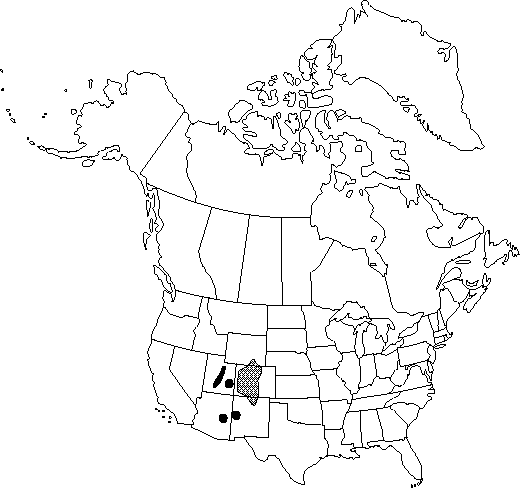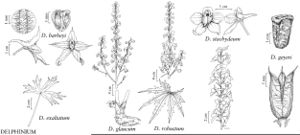Difference between revisions of "Delphinium barbeyi"
Bull. Herb. Boissier 1: 335. 1893.
FNA>Volume Importer |
FNA>Volume Importer |
(No difference)
| |
Revision as of 19:53, 24 September 2019
Stems 50-150 cm; base green, glabrous. Leaves cauline, 8-24, absent from proximal 1/5 of stem at anthesis; petiole 1-14 cm. Leaf blade round to reniform, 4-8 × 7-15 cm, glabrous; ultimate lobes 5-9, width 8-50 mm. Inflorescences 10-50-flowered; pedicel 0.5-6 cm, glandular-puberulent; bracteoles 1-4(-8) mm from flowers, blue to green, awl-shaped, 5-14 mm, puberulent. Flowers: sepals dark bluish purple, sparsely puberulent, lateral sepals forward pointing, 13-23 × 5-8 mm, spurs ascending ca. 45°, downcurved apically, 10-18 mm; lower petal blades ± covering stamens, 4-7 mm, clefts 2-3 mm; hairs centered, mostly near base of cleft, sparse elsewhere, white or yellow. Fruits 17-22 mm, 2.5-3 times longer than wide, puberulent. Seeds wing-margined; seed coat cells narrow but short, surfaces pustulate. 2n = 16.
Phenology: Flowering summer.
Habitat: Subalpine and alpine sites in wet soils
Elevation: 2500-4100 m
Distribution

Ariz., Colo., N.Mex., Utah, Wyo.
Discussion
Delphinium barbeyi hybridizes extensively with D. glaucum in western Colorado and eastern Utah, where plants appearing to be hybrid [D. ×occidentale (S. Watson) S. Watson] are often far more common than plants of either putative parent. Several other names have been used for these plants, including D. elatum var. occidentale S. Watson, D. abietorum Tidestrom, and D. scopulorum subsp. occidentale (S. Watson) Abrams. Delphinium barbeyi is also known to hybridize with D. ramosum and D. sapellonis.
Selected References
None.
